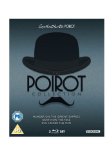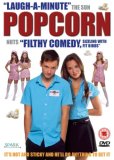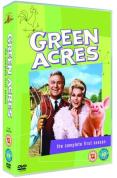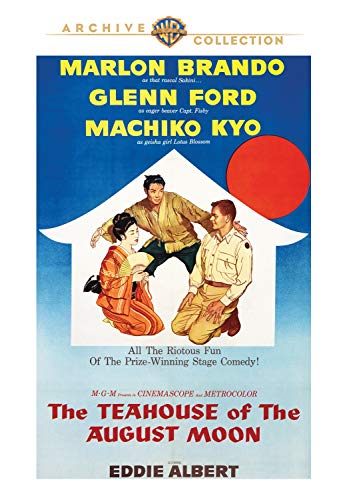![Agatha Christie's Murder On The Orient Express [1974]](/pictures/1022327.jpg) Agatha Christie's Murder On The Orient Express | DVD | (16/06/2003)
from £13.13
| Saving you £3.85 (37.97%)
| RRP
Agatha Christie's Murder On The Orient Express | DVD | (16/06/2003)
from £13.13
| Saving you £3.85 (37.97%)
| RRP The first of several lavish Christie adaptations from producers John Brabourne and Richard Goodwin introducing Albert Finney as the first screen Hercule Poirot. This 1974 production of Agatha Christie's 1934 classic is a judicious mixture of mystery murder and nostalgia. Which member of the all-star cast onboard the luxurious train perforated the no-good American tycoon with a dagger twelve times? Was it Ingrid Bergman's shy Swedish missionary; or Vanessa Redgrave's English rose; Sean Connery as an Indian Army Colonel: Michael York or Jacqueline Bisset; perhaps Lauren Bacall; Anthony Perkins or John Gielgud as the victim's impassive butler. Finney spreads unease among them with subdued wit and finesse. Arguably the most successful screen adaptation of a Christie novel in addition to Bergman's Oscar for Best Supporting Actress 'Murder On The Orient Express' achieved nominations for Best Actor Screenplay Photography Costume Design and Music Score.
![A Man Of No Importance [1995]](/pictures/1047315.jpg) A Man Of No Importance | DVD | (11/09/2006)
from £N/A
| Saving you £N/A (N/A%)
| RRP
A Man Of No Importance | DVD | (11/09/2006)
from £N/A
| Saving you £N/A (N/A%)
| RRP Dublin the early 1960's: passengers on Bus Conductor Alfie Byrne's route are entertained by a daily diet of poetry pose and excerpts from Oscar Wilde. Alfie delights his 'brethren' and attempts each year to put on a play in the church community hall. This year he wants to stage 'Salome'. When he finds his 'star' in the unsuspecting form of the delightful Adele he tries to convince his driver who has affectionately nicknamed 'Bosie' to tread the boards for the first time to no avail. Alfie soon discovers that Dublin can turn quickly into 'Peyton Place' when local butcher Carney the usurped former leading man recruits Alfie's sister and the elders from the church to condemn 'Salome' as 'the work of the devil'!
![Longest Day, The / Patton / Tora Tora Tora [1962]](/pictures/1000053.jpg) Longest Day, The / Patton / Tora Tora Tora | DVD | (19/09/2005)
from £17.99
| Saving you £2.00 (11.12%)
| RRP
Longest Day, The / Patton / Tora Tora Tora | DVD | (19/09/2005)
from £17.99
| Saving you £2.00 (11.12%)
| RRP THE LONGEST DAYTHE LONGEST DAY is a vivid hour-by-hour re-creation of June 6th 1944 - the historic day that marked the beginning of the end of World War II. Featuring a stellar international cast and told from the perspectives of both sides it is a fascinating look at the massive preparations mistakes and random events that determine the outcome of one of the biggest battles in history. THE LONGEST DAY ranks as one of Hollywood's truly great war films.PATTONA critically acclaimed film that won a total of eight 1970 Academy Awards (including Best Picture) PATTON is a riveting portrait of one of the 20th century's greatest military geniuses. Charismatic and flamboyant Patton was the only Allied general truly feared by the Nazis. He outmanoeuvred Rommel in Africa and after D-Day led his troops in an unstoppable campaign across Europe. But he was rebellious as well as brilliant and as PATTON shows with insight and poignancy his own volatile personality was one enemy he could never defeat.TORA! TORA! TORA!TORA! TORA! TORA! is the Japanese signal to attack - and the motive meticulously recreates the attack on Pearl Harbour and the events leading up to it. Opening scenes contrast the American and Japanese positions. Japanese imperialists decide to stage the attack. Top U.S. brass ignore its possibility. Intercepted Japanese messages warm of it - but never reach F.D.R.'s desk. It's the most dazzling recreation of America's darkest day - and some of her finest hours!
 Poirot Blu-ray Boxset (Murder On The Orient Express / Death On The Nile / Evil Under The Sun) | Blu Ray | (20/01/2014)
from £21.98
| Saving you £15.00 (75.04%)
| RRP
Poirot Blu-ray Boxset (Murder On The Orient Express / Death On The Nile / Evil Under The Sun) | Blu Ray | (20/01/2014)
from £21.98
| Saving you £15.00 (75.04%)
| RRP Lord Edgware Dies finds Poirot (David Suchet) reopening his London office with the help of Miss Lemon (Pauline Moran) and Captain Hastings (Hugh Fraser). As they celebrate their reunion, Japp quips that there's "only one thing missing...the body". Right on cue, a corpse turns up just moments later. Most of the suspects are actors by profession, but Poirot's "little grey cells" are able to penetrate the murderer's disguise--though only after two more victims heighten the suspense. --Larisa Lomacky Moore
![Rudyard Kipling's The Second Jungle Book - Mowgli And Baloo [DVD]](/pictures/1159164.jpg) Rudyard Kipling's The Second Jungle Book - Mowgli And Baloo | DVD | (11/04/2016)
from £3.94
| Saving you £N/A (N/A%)
| RRP
Rudyard Kipling's The Second Jungle Book - Mowgli And Baloo | DVD | (11/04/2016)
from £3.94
| Saving you £N/A (N/A%)
| RRP Based on the works of Rudyard Kipling, The Second Jungle Book tells the story of Mowgli, a young boy abandoned in the wilds of India. Raised by a panther, an elephant and a bear, Mowgli must learn civilization's ways when his long-lost uncle and a circus scout from Barnum and Bailey come looking for him. UK Key Art Synopsis: Add a new chapter to one of the best-loved adventures of all time. In this exciting live-action adventure, young Mowgli, an orphan raised by wolves, is spotted by a scout for a giant circus. Accompanied by a cruel hunter and a snake charmer, the scout sets out to trap Mowgli. But with the help of Baloo the bear and Bagheera the panther, little Mowgli leads the adults into his biggest and wildest adventure yet! A fun-filled movie every member of the family will enjoy.
 Nosferatu (1922) - Two-disc set | DVD | (22/01/2001)
from £N/A
| Saving you £N/A (N/A%)
| RRP
Nosferatu (1922) - Two-disc set | DVD | (22/01/2001)
from £N/A
| Saving you £N/A (N/A%)
| RRP Nosferatu ... the name alone can chill the blood!". F.W. Murnau's Nosferatu, released in 1922, was the first (albeit unofficial) screen adaptation of Bram Stoker's Dracula. Nearly 80 years on, it remains among the most potent and disturbing horror films ever made. The sight of Max Schreck's hollow-eyed, cadaverous vampire rising creakily from his coffin still has the ability to chill the blood. Nor has the film dated. Murnau's elision of sex and disease lends it a surprisingly contemporary resonance. The director and his screenwriter Henrik Gaalen are true to the source material, but where most subsequent screen Draculas (whether Bela Lugosi, Christopher Lee, Frank Langella or Gary Oldman) were portrayed as cultured and aristocratic, Nosferatu is verminous and evil. (Whenever he appears, rats follow in his wake.)The film's full title--Nosferatu, eine Symphonie des Grauens (Nosferatu, A Symphony of Horror)--reveals something of Murnau's intentions. Supremely stylised, it differs from Robert Wiene's The Cabinet of Dr Caligari (1919) or Ernst Lubitsch's films of the period in that it was not shot entirely in the studio. Murnau went out on location in his native Westphalia. As a counterpoint to the nightmarish world inhabited by Nosferatu, he used imagery of hills, clouds, trees and mountains (it is, after all, sunlight that destroys the vampire). It's not hard to spot the similarity between the gangsters in film noir hugging doorways or creeping up staircases with the image of Schreck's diabolic Nosferatu, bathed in shadow, sidling his way toward a new victim. Heavy chiaroscuro, oblique camera angles and jarring close-ups--the devices that crank up the tension in Val Lewton horror movies and edgy, urban thrillers such as Double Indemnity and The Postman Always Rings Twice--were all to be found first in Murnau's chilling masterpiece. --Geoffrey MacnabOn the DVD: This two-disc set gives you the choice of watching Nosferatu in either a sepia-tinted version or the original black & white. Both, however, feature the same modern electronic music score by Art Zoyd (at the movie's lavish 1922 premiere a live orchestra performed a newly composed, quasi-Wagnerian score by Hans Erdmann). The anonymous commentary track is a scholarly critical appraisal of the movie that exhaustively documents every aspect of it, from Murnau's aesthetic use of framing devices to the homoerotic subtext of the Hutter-Orlock relationship. In the "Nosferatour" featurette the movie's locations (principally, the Baltic cities of Wismer and Lubeck) are shown as they are today, and there is also a look at the original artwork that served as Murnau's inspiration. Two text features provide a brief history of the vampire myth from Vlad the Impaler onwards, as well as a discussion of the controversy caused by the movie's release. Appropriately, a trailer for the John Malkovich-Willem Dafoe movie Shadow of the Vampire, which imagines that "Max Schreck" actually was a vampire employed by Murnau in his obsessive pursuit of verisimilitude, is also included. --Mark Walker
![Out of Sight [Blu-ray] [1998]](/pictures/1106126.jpg) Out of Sight | Blu Ray | (21/03/2011)
from £12.98
| Saving you £7.01 (54.01%)
| RRP
Out of Sight | Blu Ray | (21/03/2011)
from £12.98
| Saving you £7.01 (54.01%)
| RRP Meet Jack Foley (George Clooney) the most successful bank robber in the country. On the day he busts out of jail he finds himself stealing something far more precious than money: Karen Sisco's (Jennifer Lopez) heart. She's smart sexy and unfortunately for Jack she's a Federal Marshal. Now they're willing to risk it all to find out if there's more between them than just the law...
 Popcorn | DVD | (16/07/2007)
from £19.99
| Saving you £-5.00 (N/A%)
| RRP
Popcorn | DVD | (16/07/2007)
from £19.99
| Saving you £-5.00 (N/A%)
| RRP "Popcorn" is a teen comedy about getting the girl, losing the plot and the problems you face when you turn to films for inspiration.
 Sorceress, The / The Sorceress 2 | DVD | (22/11/2004)
from £N/A
| Saving you £N/A (N/A%)
| RRP
Sorceress, The / The Sorceress 2 | DVD | (22/11/2004)
from £N/A
| Saving you £N/A (N/A%)
| RRP The Sorceress: All the pleasures of the flesh and malevolence of black magic collide with deadly force in a suburban experiment in witchcraft. Larry Barnes (Larry Poindexter) seems to be living a charmed life. He's on the fast track to a partnership in a prestigious law firm and his beautiful and sexy wife Erica (Julie Strain) will do anything to keep her husband happy even down to eliminating those who stand in the way of success. But Erica makes a final mistake when she t
![Asphalt [1929]](/pictures/1011228.jpg) Asphalt | DVD | (12/04/2005)
from £28.00
| Saving you £-8.01 (N/A%)
| RRP
Asphalt | DVD | (12/04/2005)
from £28.00
| Saving you £-8.01 (N/A%)
| RRP A well-dressed lady thief (Betty Amann) steals a precious stone from a jewellery shop. The aged jeweller prefers to let the young woman go but the policeman who catches her explains he is obliged to pursue the case further. She tries to seduce the policeman (Gustav Frohlich) and he gradually succumbs to her charms but her criminal background dooms their relationship when an argument leads to murder... One of the last great German Expressionist films of the silent era Joe May's 'A
![The Take [DVD]](/pictures/1152959.jpg) The Take | DVD | (14/10/2019)
from £8.05
| Saving you £N/A (N/A%)
| RRP
The Take | DVD | (14/10/2019)
from £8.05
| Saving you £N/A (N/A%)
| RRP Crime fighter Terry Sneed arrives in New Mexico to help out a local police chief - but he's already taking money from the underworld.
 Green Acres Season 1 | DVD | (04/12/2006)
from £N/A
| Saving you £N/A (N/A%)
| RRP
Green Acres Season 1 | DVD | (04/12/2006)
from £N/A
| Saving you £N/A (N/A%)
| RRP Eddie Albert and Eva Gabor star as an upper-class couple who leave their flashy New York City lifestyle behind and move to the country. Of course that transition proves to be more difficult they anticipated triggering a seemingly endless string of hilarious situations. Episodes Comprise: 1. Oliver Buys A Farm 2. Lisa's First Day On The Farm 3. The Decorator 4. The Best Laid Plans 5. My Husband The Rooster Renter 6. Furniture Furniture Who's Got The Furniture? 7. Neighbours 8. Lisa The Helpmate 9. You Can't Plug In A 2 With A 6 10. Don't Call Us We'll Call You 11. Parity Begins At Home 12. Lisa Has A Calf 13. The Wedding Anniversary 14. What Happened In Scranton 15. How To Enlarge A Bedroom 16. Give Me Land Lots Of Land 17. I Didn't Raise My Husband To Be A Fireman 18. Lisa Bakes A Cake 19. Sprained Ankle Country Style 20. The Price Of Apples 21. What's In A Name? 22. The Day Of Decision 23. A Pig In A Poke 24. The Deputy 25. Double Drick 26. The Ballad Of Molly Turgiss 27. Never Look A Gift Tractor In The Mouth 28. Send A Boy To College 29. Horse? What Horse? 30. The Rains Came 31. Culture 32. Uncle Ollie
 Dreamscape | DVD | (11/02/2008)
from £20.00
| Saving you £-10.01 (-100.20%)
| RRP
Dreamscape | DVD | (11/02/2008)
from £20.00
| Saving you £-10.01 (-100.20%)
| RRP The President of the United States is about to be assassinated in a dream where there is no morning after. Only one man can save him - a man who must plunge himself into the President's horrendous nightmare. Dennis Quaid stars as Alex Gardner a psychically gifted young man recruited to help Dr. Paul Novotny (Max Von Sydow) and the beautiful Dr. Jane DeVries (Kate Capshaw) in an experiment to help patients disturbed by menacing nocturnal illusions. But corrupt high-ranking government official Bob Blair (Christopher Plummer) has darker plans for Alex's unusual powers. Soon Alex is propelled inside the President's nightmare a frightening wasteland of nuclear holocaust and locked in a fantastic battle that could only happen in a dream.
 Texas Blues Guitar | DVD | (12/12/2012)
from £16.37
| Saving you £8.62 (34.50%)
| RRP
Texas Blues Guitar | DVD | (12/12/2012)
from £16.37
| Saving you £8.62 (34.50%)
| RRP A compilation of Texas blues guitar including: 'Iceman' 'Lights Are On' 'Head Rag' 'Going Down' 'Bunion Stew' 'God Moves On The Water' and more.
![Respect [Blu-ray]](/pictures/1157535.jpg) Respect | Blu Ray | (09/11/2021)
from £19.37
| Saving you £N/A (N/A%)
| RRP
Respect | Blu Ray | (09/11/2021)
from £19.37
| Saving you £N/A (N/A%)
| RRP ![Business Is Business [1971]](/pictures/1006095.jpg) Business Is Business | DVD | (27/05/2002)
from £10.35
| Saving you £9.64 (93.14%)
| RRP
Business Is Business | DVD | (27/05/2002)
from £10.35
| Saving you £9.64 (93.14%)
| RRP A bawdy, though sympathetic look at the lives of two Amsterdam prostitutes, 1971s Business is Business was the film debut of Dutch director Paul Verhoeven, who would later graduate to the Hollywood mainstream with films like Total Recall and Basic Instinct. Starring Ronnie Biermann as Greet, a worldly wise prostitute who, in between gratifying the often bizarre needs and fantasies of her bourgeois clients, is decently protective of her neighbour and friend in the trade, the busty, younger Nell of whose relationship with an abusive leech (Bernard Droog) she disapproves. Finally, she decides they must both break out of their decreasingly fulfilling lives and seek out matrimonial stability. An amiable if slightly aimless movie, based on the writings of Albert Moll, Business is Business probably seemed like an authentic depiction of the Amsterdam demi-monde in its day. Today, its kinky peccadilloes look rather quaint in comparison with, say, Nick Broomfields Fetishes. The breezily kitsch soundtrack is redolent of a more innocent age overall. However, both Biermann and Sylvia De Leur forcefully resist any of the dollybird clichés of the era in their strong characters.--David Stubbs On the DVD: Business is Business on disc can be viewed with or without English subtitles. Extras are disappointing with only a Verhoeven, Biermann and De Leur filmography and film notes from David Parkinson, along with a few World cinema trailers and the films original trailer. The image resolution is average for a 1971 film and the Dolby digital soundtrack enhances the grunts and groans.--Nikki Disney
 Danielle Steel's Star | DVD | (30/06/2003)
from £5.35
| Saving you £0.64 (11.96%)
| RRP
Danielle Steel's Star | DVD | (30/06/2003)
from £5.35
| Saving you £0.64 (11.96%)
| RRP The death of her loving father shatters 16-year-old Crystal's (Jennie Garth) happy life on a remote ranch. Abused by her bitter mother she's first raped then blamed for the tragic shooting of her younger brother and finally banished from the family home. Alone and penniless she flees to San Francisco and takes a job as a waitress in a night club. Her unique singing talents are soon noticed however and before long she's carving out a sparkling recording career. By chance Crystal meets up with her one true childhood love Spencer Hill (Craig Bierko) who's now engaged to a powerful society beauty. Though infatuated with each other they realise they must go their separate ways - both eventually reaching the pinnacle of their careers. But fame and fortune can never eclipse true love. So when fate finally brings them together again will more than a decade of triumphs and tragedies once more stand in the way of happiness and love?
 The Teahouse of the August Moon | DVD | (20/11/2018)
from £27.97
| Saving you £N/A (N/A%)
| RRP
The Teahouse of the August Moon | DVD | (20/11/2018)
from £27.97
| Saving you £N/A (N/A%)
| RRP ![The World At War - Vol. 3 [1973]](/pictures/1004314.jpg) The World At War - Vol. 3 | DVD | (09/10/2000)
from £16.16
| Saving you £8.83 (35.30%)
| RRP
The World At War - Vol. 3 | DVD | (09/10/2000)
from £16.16
| Saving you £8.83 (35.30%)
| RRP When this epic series was first broadcast in 1973 it redefined the gold standard for television documentary; it remains the benchmark by which all factual programming must judge itself. Originally shown as 26 one-hour programmes, The World at War set out to tell the story of the Second World War through the testimony of key participants. The result is a unique and unrepeatable event, since many of the eyewitnesses captured on film did not have long left to live. Each hour-long programme is carefully structured to focus on a key theme or campaign, from the rise of Nazi Germany to Hitler's downfall and the onset of the Cold War. There are no academic "talking heads" here to spell out an official version of history; the narration, delivered with wonderful gravitas by Sir Laurence Olivier, is kept to a minimum. The show's great coup was to allow the participants to speak for themselves. Painstaking research in the archives of the Imperial War Museum also unearthed a vast quantity of newsreel footage, including on occasion the cameraman's original raw rushes which present an unvarnished and never-before-seen picture of important events. Carl Davis' portentous main title theme and score underlines the grand scale of the enterprise. The original 26 episodes were supplemented three years later by six special programmes (narrated by Eric Porter), bringing the total running-time to a truly epic 32 hours. Now digitally remastered The World at War looks even more of an impressive achievement on DVD. Available in five volumes, each handsomely packaged double-disc set comes with a detailed menu that places the individual programmes along a chronological timeline. Better yet, chapter access is laid out to allow you to select key speeches or maps or newsreel footage. The World at War was a landmark television event; its DVD incarnation underlines its importance as an historical document. --Mark Walker
![The World At War - Vol. 1 [1973]](/pictures/1004345.jpg) The World At War - Vol. 1 | DVD | (28/08/2000)
from £5.25
| Saving you £4.74 (90.29%)
| RRP
The World At War - Vol. 1 | DVD | (28/08/2000)
from £5.25
| Saving you £4.74 (90.29%)
| RRP When this epic series was first broadcast in 1973 it redefined the gold standard for television documentary; it remains the benchmark by which all factual programming must judge itself. Originally shown as 26 one-hour programmes, The World at War set out to tell the story of the Second World War through the testimony of key participants. The result is a unique and unrepeatable event, since many of the eyewitnesses captured on film did not have long left to live. Each hour-long programme is carefully structured to focus on a key theme or campaign, from the rise of Nazi Germany to Hitler's downfall and the onset of the Cold War. There are no academic "talking heads" here to spell out an official version of history; the narration, delivered with wonderful gravitas by Sir Laurence Olivier, is kept to a minimum. The show's great coup was to allow the participants to speak for themselves. Painstaking research in the archives of the Imperial War Museum also unearthed a vast quantity of newsreel footage, including on occasion the cameraman's original raw rushes which present an unvarnished and never-before-seen picture of important events. Carl Davis' portentous main title theme and score underlines the grand scale of the enterprise. The original 26 episodes were supplemented three years later by six special programmes (narrated by Eric Porter), bringing the total running-time to a truly epic 32 hours. Now digitally remastered The World at War looks even more of an impressive achievement on DVD. Available in five volumes, each handsomely packaged double-disc set comes with a detailed menu that places the individual programmes along a chronological timeline. Better yet, chapter access is laid out to allow you to select key speeches or maps or newsreel footage. The World at War was a landmark television event; its DVD incarnation underlines its importance as an historical document. --Mark Walker

Please wait. Loading...
This site uses cookies.
More details in our privacy policy